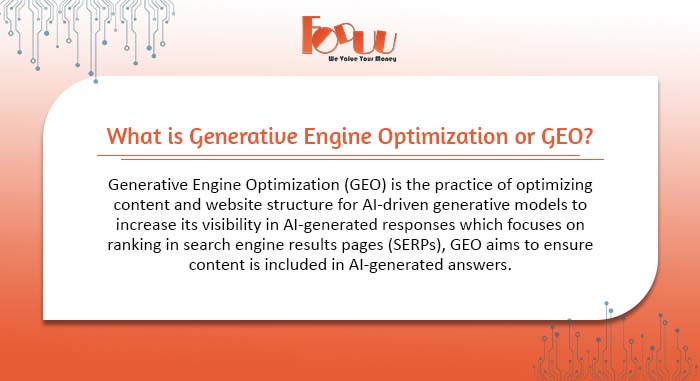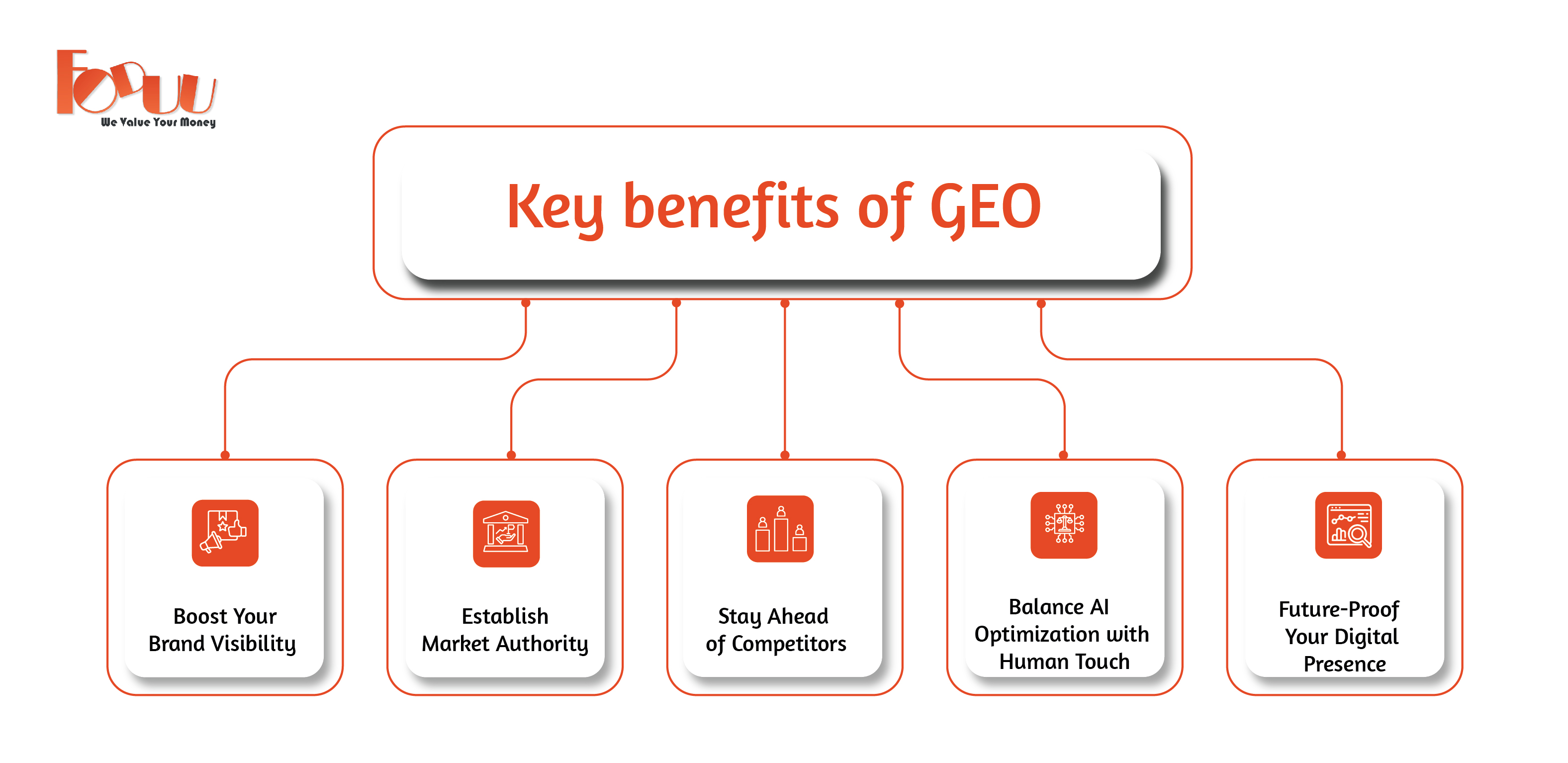Virtual reality is undergoing a revolution with AI-powered search engines. Older Search Engine Optimization (SEO) techniques, although still very much relevant at one time, do not work anymore. Hence enters stage left Generative Engine Optimization or GEO, an intriguing new technique that answers what one must do to optimize content for AI-powered search engines. This detailed report analyzes GEO dynamics, their significance, benefits, workings, and prospects.
What is Generative Engine Optimization or GEO?

Generative Engine Optimization, better known as GEO, works toward making web content search-usable in AI-generated responses. Contrarily, generic SEO is used to influence the ranking of a website on a search result page, while GEO tries to make your content readable, extractable, and citable by AI engines like ChatGPT, Google's Bard, and Perplexity to have it considered an answer to users' queries. The attacks that GEO aims to achieve are getting your content cited by these AI platforms themselves and, therefore, popularizing and having your brand recognized online.
GEO vs. SEO: Convergence, Divergence
Both SEO and GEO are made to increase website visibility, but they do so in a mutually antagonistic way:
Targeting Platforms: Another search engine optimization target is old search engines like Bing and Google, and backlinks and keywords are concerned with trying to optimize SERP ranking. GEO targets AI-driven platforms providing synthesized responses like ChatGPT and Google AI Summaries.
Content Structure: SEO involves keyword density, meta tags, and link equity management. GEO entails putting forth something that is in-depth, well-structured, and readable to AI. It means brief headings, short paragraphs, and fact-based information to make it AI readable and citeable.
Indicators of Success: Organic traffic, bounce rate, and click-through rate are the indicators for success for SEO. GEO is considered successful if its contents are frequently and widely cited in AI outputs in terms of authority and relevance.
Thus, whereas SEO strives to place content in order to appeal to human users via search results, GEO strives to place content as an authority on information through the AI application.
Related Post: Business Benefits of Artificial Intelligence (AI)
Why GEO Is Important?
AI search engines reshaped how consumers consume information. Instead of going through several web pages, users are presented with the direct answer options as summarized by the AI models. The trend indicates non-AI-friendly content is being avoided. Making your content accessible with GEO practices is a step toward making your content accessible and credible in this new search world so that you can engage end-users who consume AI-based content.
Key benefits of GEO

Improved Visibility: SEO of the AI platform optimizes the probability of getting your name acknowledged by the answers so that exposure is given to the masses.
Building Authority: Continuous presence in AI answers legitimizes your business and allows you to build authority and credibility in the marketplace.
Competitive Advantage: Being a frontrunner GEO member keeps you ahead of the competition now trying to understand sub-optimized content slipping behind the AI platforms.
Flexibility: GEO is very passionate about writing that is AI-optimized but at the same time human-friendly, opening to readability and relevance that anyone can cherish.
Future-Proofing: Because AI development is running at breakneck speed, the AI-optimized content for generative engines will definitely get more exposure and use on the internet.
How GEO Works?
Exercises that should be done for GEO are:
Structure of Content: Break content into headings, bullet points, and short paragraphs that can be easily parsed and better understood by AI.
Factual Correctness: Make sure that numbers remain recent and always accurate since AI models will learn from the best source of information based on their responses.
Contextual Relevance: Approach the subjects holistically, with definitions, examples, and corroborating facts for maximum content depth and value.
Semantic Optimization: Highlight particular keywords and terminologies that are specific to inform AI models about the overall context of what you are writing.
Markup Usage: Schema markups are necessary together with any other markups for specifying further context to the AI models so that the content can be identified and marked relevant. If you respect these conventions, your content will be much more readable and enjoyable for AI systems, hence having greater chances of being used in AI-generated content.
Interesting GEO Features in the Future
With the progress of AI technologies, GEO shall serve in bigger exploitation. More learned AIs will be given, demanding higher-grade content in form and content. If AI gets deployed on web portals other than search engines, then GEO strategy will have to be implemented in all digital media. The use of GEO by people today who understand it will enable them to put it to use throughout the entire journey through transitions heard and seen in an AI-complete digital landscape.
Related Post: How to Find the Right AI Development Company
Generative Engine Optimization (GEO): FAQs
Q1: Is SEO dying and being replaced by GEO?
No, GEO is simply another version of SEO. SEO stands for Search Engine Optimized while GEO means AI-Optimized. One would need both for complete digital visibility.
Q2: How do I begin with GEO?
Start with taking stock of your current content to see if it is well formatted, readable, and up to date. Use semantic terminology, mark it up correctly, and ensure that your content is actually answering questions standard users have.
Q3: Are there GEO effectiveness measures?
Yes, GEO is the relatively newer business today, and there are tools by experts, which are scarce even today. One of the signs of GEO realization is when and how often your content is in AI responses.
Q4: Are GEO concepts applied to all content types?
Yes, GEO principles can be applied to almost all types of content, e.g., blog posts, product copies, FAQs, etc. At the bare minimum, content shall be rendered and organized with data to meet AI comprehension and user needs.
Q5: How often do I need to update my GEO strategies?
One should keep updating and revising the content periodically so that one could make it accurate and up-to-date.
Conclusion
In changing AI models, it becomes even more important for you to stay updated with changing patterns of AI behaviour and update your GEO plans to maintain visibility in the long run-a brief of GEO is web content revolution, an escape route to the ever-increasing stranglehold of AI on information dissemination. Using GEO, companies and content creators can make content visible, audible, and meaningfully relevant in a cluttered virtual world of AI.
Future-Proof Your Digital Presence with Our GEO Services
Partner with FODUU, One of the best website design company in India. We specialize in building user-focused, responsive, and high-performance websites and applications for clients worldwide. Our GEO-optimized solutions are designed to help your content rank higher in AI-powered search results. Let’s take your online presence to the next level— Get started today.

.png)


